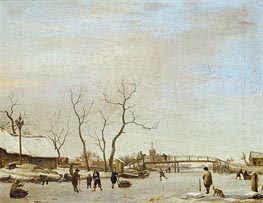
Adriaen van de Velde Giclée Fine Art Prints
1636-1672
Dutch Baroque Painter
Adriaen van de Velde is a painter whose work invites contemplation - not of grand historical narratives or turbulent seascapes, but of the tranquil and the intimate. Born in Amsterdam in 1636, into a family famous for its marine painters, van de Velde broke away from tradition. He sought not the vastness of the ocean but the quietude of pastoral landscapes, where humans and animals coexist in a peaceful, almost idyllic harmony. His work is characterized by a remarkable sensitivity to light and a delicate balance of composition, and though his career was tragically brief, it left a profound impression on the Dutch Golden Age.
Van de Velde’s early training was with his father, Willem van de Velde the Elder, but it was his time in Haarlem, under the guidance of landscape painter Jan Wynants, that truly shaped his artistic voice. In Haarlem, he encountered figures like Paulus Potter and Philip Wouwerman, both animal painters who deeply influenced van de Velde’s depictions of cattle, horses, and herdsmen. His landscapes, whether depicting summer meadows or sunlit beaches, exude a serene atmosphere, each figure and animal carefully integrated into the scene with a precision that feels almost effortless.
What stands out most in van de Velde’s oeuvre is his extraordinary attention to detail - not in a cold or clinical way, but in a way that imbues every scene with a quiet reverence for nature. His landscapes are studies in simplicity and balance, where the light seems to gently fall on each figure, tree, or cloud, giving the whole a soft, golden glow. His ability to render such subtlety in light and form has often been compared to the Italianate painters, like Karel Dujardin, whose works inspired a more poetic approach to the landscape. Yet, van de Velde’s vision remains distinctly his own, rooted in the Dutch countryside but with a lyrical quality that transcends the purely local.
Despite his undeniable talent, van de Velde’s life was marred by financial struggle. He married Maria Pieters Oudekerck, a Catholic, and converted to her faith, which likely added to the difficulties they faced in Amsterdam, where Catholicism was still largely practiced in secret. Maria had to support the family by running a linen business, and when van de Velde died in 1672 at just 35, his debts were still unpaid. But the hardship of his personal life never seems to intrude upon the gentle beauty of his art. His landscapes - with their cows grazing peacefully, their herdsmen resting under trees - offer a glimpse of a world untouched by strife, where nature’s rhythms hold sway and time seems to stand still. In his short life, Adriaen van de Velde created a body of work that remains, above all, a testament to the quiet power of observation.
Van de Velde’s early training was with his father, Willem van de Velde the Elder, but it was his time in Haarlem, under the guidance of landscape painter Jan Wynants, that truly shaped his artistic voice. In Haarlem, he encountered figures like Paulus Potter and Philip Wouwerman, both animal painters who deeply influenced van de Velde’s depictions of cattle, horses, and herdsmen. His landscapes, whether depicting summer meadows or sunlit beaches, exude a serene atmosphere, each figure and animal carefully integrated into the scene with a precision that feels almost effortless.
What stands out most in van de Velde’s oeuvre is his extraordinary attention to detail - not in a cold or clinical way, but in a way that imbues every scene with a quiet reverence for nature. His landscapes are studies in simplicity and balance, where the light seems to gently fall on each figure, tree, or cloud, giving the whole a soft, golden glow. His ability to render such subtlety in light and form has often been compared to the Italianate painters, like Karel Dujardin, whose works inspired a more poetic approach to the landscape. Yet, van de Velde’s vision remains distinctly his own, rooted in the Dutch countryside but with a lyrical quality that transcends the purely local.
Despite his undeniable talent, van de Velde’s life was marred by financial struggle. He married Maria Pieters Oudekerck, a Catholic, and converted to her faith, which likely added to the difficulties they faced in Amsterdam, where Catholicism was still largely practiced in secret. Maria had to support the family by running a linen business, and when van de Velde died in 1672 at just 35, his debts were still unpaid. But the hardship of his personal life never seems to intrude upon the gentle beauty of his art. His landscapes - with their cows grazing peacefully, their herdsmen resting under trees - offer a glimpse of a world untouched by strife, where nature’s rhythms hold sway and time seems to stand still. In his short life, Adriaen van de Velde created a body of work that remains, above all, a testament to the quiet power of observation.
1 Adriaen van de Velde Artworks

Giclée Canvas Print
$54.70
$54.70
SKU: 16487-VVA
Adriaen van de Velde
Original Size:23 x 30 cm
Louvre Museum, Paris, France
Adriaen van de Velde
Original Size:23 x 30 cm
Louvre Museum, Paris, France